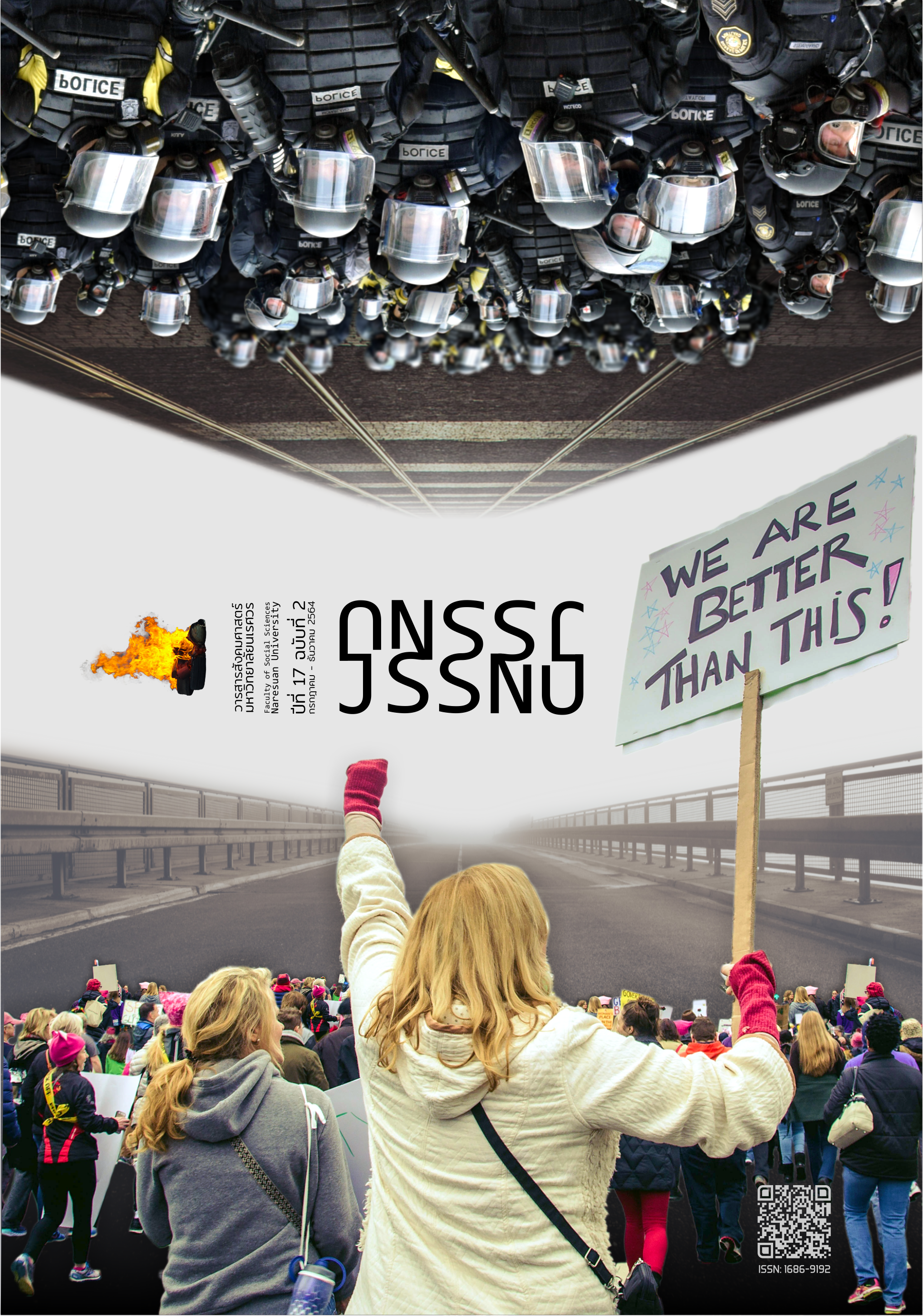Contentious Bodies: Body as a Site of Resistance in 2020–2021 Thailand’s Pro-Democracy Movement
Main Article Content
Abstract
This paper aims to examine the body as topos for political contention during 2020-2021 Thailand’s pro-democracy movement, focusing on the body of the demonstrators from several groups including People’s Party 2020, Thalufah, and FreeArts in the demonstration sites as well as the body of the individuals who utilise their bodies to express their political stance in daily life through the lenses of body politics theories, especially the concept of Choreography of protest propounded by Susan Leigh Foster (2003). This paper argues that the bodily expression in the contemporary democracy movement in Thailand has rendered the protest against the monarchy as well as the dictatorial regime a “performance” that can be categorised into two groups: 1. The performance at the site of protest to reduce the distance according to Tali Hatuka’s concept of distance and 2. The performance in quotidian life as culture jamming. These performances extend the democracy movement from the ideological realm to the realm of the body, resulting in decreasing the distance between the state and its people through the use humorous cosplay to ridicule the holiness of the monarchy. At the same time, the physical display of suffering at the demonstration site reduce the distance among demonstration leaders, the demonstrators, as well as the audience. Furthermore, the contentious performance incorporates daily lives of the demonstrators as part of the “culture jamming” through the appropriation of pop culture in order to establish democratic, “au courant” bodies that are aligned with the Woke culture. As a result, these physical protests have turned contemporary pro-democracy movements in Thailand as convergence of ideological struggles in the political realm and individual’s life experiences.
Downloads
Article Details
References
Amed, I., Balchandani, A., Beltrami, M., Berg, A., Hedrich, S., & Rölkens, F. (2019). The influence of ‘woke’ consumers on fashion. Retrieved January 15, 2021, from https://www.mckinsey.com/industries/retail/our-insights/the-influence-of-woke-consumers-on-fashion#
Bargu, B. (2016). Starve and immolate: The politics of human weapons. Columbia: Columbia University Press
Barthes, R., & Stafford, A. (2013). The language of fashion. Oxford: Berg.
Bourdieu, P. (1984). Distinction: A social critique of the judgement of taste. London: Routledge & Kegan Paul.
Certeau, M., & Rendall, S. (1988). The practice of everyday life. Berkeley: University of California Press.
Chiengsan, U. (2018). Civil politics. Bangkok: Matichon. [in Thai].
Chiwarak, P. (2021, April 14). Penguin Parit has been going on hunger strike for 30 days: Family revealed he has lost almost 20 kilogram, while Roong Panasaya has been starving herself for 16 days [Interviewed by the editor]. The Matter. Retrieved from https://thematter.co/brief/140515/140515 [in Thai].
Dreyer, E. (2016). Rubber ducks and ships of fools. Third Text, 30,(3-4), 274-290. doi: 10.1080/09528822.2017.1323412
Eoseewong, N. (2017, April 7). Subjects under the theatre State(1). Matichon Weekly. Retrieved from https://www.matichonweekly.com/column/article_30805 [in Thai].
Everyone can lead: The first organic demonstrations without the leader in three decades. (2020, October 18). Prachachart. Retrieved from https://www.prachachat.net/politics/news-540054 [in Thai].
Foucault, M. (1978). The history of sexuality. New York: Pantheon Books.
Foster, S. (2003). Choreographies of protest. Theatre Journal, 55(3), 395-412. doi: 10.1353/tj.2003.0111
Hatuka, T. (2018). Design of protest: Choreographing political demonstrations in public space. Austin: University of Texas Press.
Hoffer, Eric. (1951). The true believer: Thoughts on the nature of mass movements. New York: Harper Perennial Modern Classics
Koestler, A. (1970). The act of creation. London: Hutchinson.
Kristeva, J. (1982). Powers of horror: An essay on abjection. New York: Columbia University Press.
Lertchoosakul, K. (2021). The cold war (in)between the white ribbon. Bangkok: Matichon. [in Thai].
Mbembé, A., & Libby M. (2003). Necropolitics. Public Culture, 15(1), 11-40. doi: 10.1057/9780230584334_9
Nomai, J. (2008). Culture jamming: Ideological struggle and the possibilities forsocial change (Doctoral dissertation). Austin: University of Texas at Austin. Retrieved from https://repositories.lib.utexas.edu/handle/2152/3971
Nongnuch, P. (2021, January 1). Report on “Kana Ratsadorn” movement: From 2020 to new challenges in 2021. Matichon Weekly. Retrieved from https://www.matichonweekly.com/column/article_382926 [in Thai].
Supachalasai, C. (2017). The internet politics, time and remembering trauma. Journal of Social Sciences, Naresuan University, 13(1), 49-67. doi: 10.14456/jssnu.2017.4 [in Thai].
Symes, C., & Daphne M. (1996). Force of habit :The school uniform as a body of knowledge. Counterpoints, 29, 171-191. doi: 10.1111/1467-8527.00044
Yodhong, C. (2021, May 4). When women shaved their heads: The birth of the new beauty and the redefining of skinhead. The Matter. Retrieved from https://thematter.co/thinkers/skinhead-against-injustice/142015 [in Thai].


